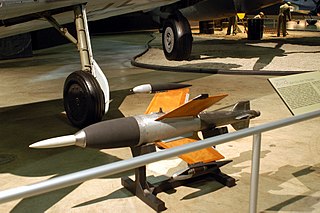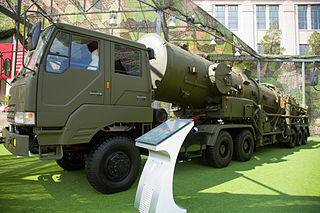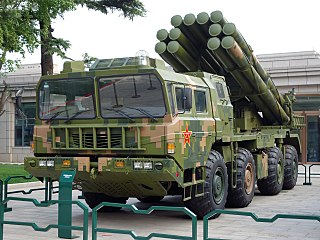History
One of the problems for the German military, and indeed any mobile military force, is the weight of the artillery and, more importantly, its ammunition supply. Battlefield rockets were intended to circumvent the problems, which led to the development of Rheinbote. The Rheinbote was the successor of the earlier Rheintochter (Rhine Maiden). [3]
Developed in 1943 by the Rheinmetall-Borsig company, Rheinbote was a four-stage solid-fuelled rocket, and the only long-range battlefield ballistic missile to enter service in World War II. [4] The first test flights were carried out that year. Several changes were made to the system, but the basic design remained the same. It measured 11.4 m (37 ft 5 in), with fins at the tail and one set of additional fins at each stage. [5] The propellant was a diglycol dinitrate mix, which enabled test models to achieve a speed of 6,800 km/h (4,200 mph; 3,700 kn), the fastest rocket of the period. [5]
The Rheinbote carried a 40 kg (88 lb) warhead (just 2.3% of the missile's total weight) [5] to a height of 78,000 m (256,000 ft), [5] for an effective range of 160 km (99 mi; 86 nmi); it reached over 220 km (140 mi; 120 nmi) in testing. [5] For shorter ranges, some of the stages could be removed. It was launched from a simple rail on a mobile trailer, based on the one used to transport the V-2. [5] It was aimed simply by pointing the trailer and elevating the launch gantry, a method not guaranteed to be accurate. [5]
Over 220 were constructed, [6] with over 200 being used against the Belgian port of Antwerp between November 1944 and the end of the war. [5] They caused only limited damage in small unpredictable areas of the city. [7]
Some were fired from positions near the town of Nunspeet in the Netherlands.
The concept of long-range artillery rockets on the battlefield would remain undeveloped after the war. Even Rheinbote was not used in its intended role, but instead as a smaller version of the V-2 missile in the strategic role, for which its warhead was essentially useless due to its poor accuracy, small size, and its fusing, since it tended to bury itself in the ground before exploding. [5]
After the war, the Soviet Union seized the design. [5]

An intercontinental ballistic missile (ICBM) is a ballistic missile with a range greater than 5,500 kilometres (3,400 mi), primarily designed for nuclear weapons delivery. Conventional, chemical, and biological weapons can also be delivered with varying effectiveness, but have never been deployed on ICBMs. Most modern designs support multiple independently targetable reentry vehicle (MIRVs), allowing a single missile to carry several warheads, each of which can strike a different target. The United States, Russia, China, France, India, the United Kingdom, Israel, North Korea and Iran are the only countries known to have operational ICBMs.

The Dongfeng series, typically abbreviated as "DF missiles", are a family of short, medium, intermediate-range and intercontinental ballistic missiles operated by the Chinese People's Liberation Army Rocket Force.

The Army Ballistic Missile Agency (ABMA) was formed to develop the U.S. Army's first large ballistic missile. The agency was established at Redstone Arsenal on 1 February 1956, and commanded by Major General John B. Medaris with Wernher von Braun as technical director.

Rheintochter was a German surface-to-air missile developed by Rheinmetall-Borsig during World War II. Its name comes from the mythical Rheintöchter (Rhinemaidens) of Richard Wagner's opera series Der Ring des Nibelungen.

The Ruhrstahl Ru 344 X-4 or Ruhrstahl-Kramer RK 344 was a wire-guided air-to-air missile designed by Germany during World War II. The X-4 did not see operational service and thus was not proven in combat but inspired considerable post-war work around the world, and was the basis for the development of several ground-launched anti-tank missiles.

The R-2 was a Soviet short-range ballistic missile developed from and having twice the range as the R-1 missile. Developed from 1946-1951, the R-2 entered service in numbers in 1953 and was deployed in mobile units throughout the Soviet Union until 1962. A sounding rocket derivative, the R-2A, tested a prototype of the dog-carrying capsule flown on Sputnik 2 in 1957. The same year, the R-2 was licensed for production in The People's Republic of China, where it entered service as the Dongfeng 1.

The PGM-19 Jupiter was the first nuclear armed, medium-range ballistic missile (MRBM) of the United States Air Force (USAF). It was a liquid-propellant rocket using RP-1 fuel and LOX oxidizer, with a single Rocketdyne LR79-NA rocket engine producing 667 kilonewtons (150,000 lbf) of thrust. It was armed with the 1.44 megatons of TNT (6.0 PJ) W49 nuclear warhead. The prime contractor was the Chrysler Corporation.

The MGR-1 Honest John rocket was the first nuclear-capable surface-to-surface rocket in the United States arsenal. Originally designated Artillery Rocket XM31, the first unit was tested on 29 June 1951, with the first production rounds delivered in January 1953. Its designation was changed to M31 in September 1953. The first Army units received their rockets by year's end and Honest John battalions were deployed in Europe in early 1954. Alternatively, the rocket was capable of carrying an ordinary high-explosive warhead weighing 1,500 pounds (680 kg).

Prithvi is a tactical surface-to-surface short-range ballistic missile (SRBM) developed by Defence Research and Development Organisation (DRDO) of India under the Integrated Guided Missile Development Program (IGMDP). It is deployed by India's Strategic Forces Command.

The RT-2 was an intercontinental ballistic missile deployed by the Soviet Union, which was in service from December 1968 until 1976. It was assigned the NATO reporting name SS-13 Savage and carried the GRAU index 8K98. Designed by OKB-1, about 60 were built by 1972.
RS-82 and RS-132 were unguided rockets used by Soviet military during World War II.

The Hatf I is a land-based tactical and battlefield range ballistic missile, currently in service with the strategic command of the Pakistan Army.

The Dong-Feng 15 is a short-range ballistic missile developed by the People's Republic of China. The DF-15 and the newer DF-16 are thought to be the only non-nuclear missiles in use by the People's Liberation Army Rocket Force. The U.S. Department of Defense estimated in 2008 that China had 315–355 DF-15 missiles and 90–110 launchers.

The Weishi family of multiple rocket launcher systems were mainly developed by Sichuan Aerospace Industry Corporation in Chengdu, China. The systems include the 302 mm (11.9 in) WS-1, the improved 302 mm (11.9 in) WS-1B, the 122 mm (4.8 in) WS-1E, the 400 mm (16 in) WS-2, as well as many other models. The WS-1 series weapon system did not enter PLA service and has order from Thailand. The WS-2 may finally see PLA service in the future. It's worth noticing that although sharing the same name, there are other developers for different models of Weishi series multiple rocket launchers (MRL) other than the primary developer SCAIC.

The Dong-Feng 21 (DF-21; NATO reporting name CSS-5 - Dong-Feng is a two-stage, solid-fuel rocket, single-warhead medium-range ballistic missile in the Dong Feng series developed by China Changfeng Mechanics and Electronics Technology Academy. Development started in the late 1960s and was completed around 1985–86, but it was not deployed until 1991. It was developed from the submarine-launched JL-1 missile, and is China's first solid-fuel land-based missile. The U.S. Department of Defense in 2008 estimated that China had 60-80 missiles and 60 launchers; approximately 10-11 missiles can be built annually.
The B-611 is a Chinese solid-fuelled short-range ballistic missile (SRBM) developed by China Precision Machinery Import-Export Corporation (CPMIEC). The missile has a maximum range of 150–400 km (93–249 mi).

The PHL-03 is a truck-mounted self-propelled 12-tube 300 mm long-range multiple rocket launcher of the People's Republic of China.
BRE is a series of guided rockets (missiles) manufactured by Chinese Norinco.

The 45 cm naval rocket was a rocket artillery system used by garrison troops of the Imperial Japanese Navy during the late stages of World War II in defense of island bases in the Pacific.
















